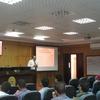Explore all the information on
Poultry management
Poultry management usually refers to the husbandry practices or production techniques that help to maximize the efficiency of production. Sound management practices are very essential to optimize production. Scientific poultry management aims at maximizing returns with minimum investment. A carefully controlled environment that avoids crowding, chilling, overheating, or frightening is almost universal in poultry farming. Cannibalism, which expresses itself as toe picking, feather picking, and tail picking, is controlled by debeaking at one day of age and by other management practices. The feeding, watering, egg gathering, and cleaning operations are highly mechanized. Birds are usually housed in wire cages with two or three animals per cage, depending on the species and breed, and three or four tiers of cages superposed to save space. Cages for egg-laying birds have been found to increase production, lower mortality, reduce cannibalism, lower feeding requirements, reduce diseases and parasites, improve culling, and reduce both space and labour requirements.
Casey Ritz, Professor and Extension Specialist at the University of Georgia, talked about techniques and management practices to comply with regulations in processing poultry litter, during IPPE 2017 in Atlanta, USA....
Comments : 0
Recommendations: 0
Joseph Hess, Professor and Extension Specialist at Auburn University, talked about moisture in poultry litter, water quality, and environmental concerns, during IPPE 2017 in Atlanta, USA....
Comments : 0
Recommendations: 1
Broiler Farming Broilers are chicken raised specially for meat production. Broilers are typically the cross bred of Plymouth Rock and Cornish. Poultry meat is an important source of high quality proteins, minerals, and vitamin to balance the human diet. Advantage of Broiler Farming Initial investment is a little lower than layer farming. Rearing Period is 6-7 weeks...
Comments : 19
Recommendations: 1
A free workshop will be offered to International Production & Processing Expo (IPPE) attendees on the Toxic Release Inventory (TRI) program. The U.S. Poultry & Egg Association (USPOULTRY) is sponsoring this free session to provide a basic overview of TRI reporting as well as offer greater details on intricate aspects of the reporting requirements that are routinely confusing and ambiguous due to the lack of endorsed guidance.
This program will be held from 8 – 10:00...
Comments : 0
Recommendations: 0
In recent times i discovered my broiler breeder stock close vent as early as 40 weeks. This has been my major concern as it affects their production. what can likely be the cause of this and how can I prevent re-occurrence.My management practices have been the same for the pass 5 years. Thanks...
Comments : 0
Recommendations: 0
The UGA International Poultry Short Course provides poultry professionals with an intensive educational experience containing relevant, up to date information related to modern broiler production. Topics in the 2017 course will focus on management, health and processing issues related to maximizing performance of the modern broiler.
...
Comments : 12
Recommendations: 0
On March 27, 2009, the Ontario government introduced Ontario Regulation 106/09, which applies to all producers who manage deadstock on-farm. The new regulation applies to poultry producers, which its predecessor did not, and outlines specific requirements for disposing of deadstock. The new Regulation stipulates specific setback distances for deadstock composting that apply to neighbouring landuses and sensitive features, such as wells and surface...
Comments : 2
Recommendations: 0
On November 14-16, 2016, the UGA Cold Weather Management Workshop will be conducted at the Oconee County Civic Center in Watkinsville, Georgia, a few miles from the University of Georgia. This intensive training program has been specifically designed for those who want to learn more about the design and management of modern poultry houses. The workshop consists of lectures as well as hands on group exercises designed to help attendees gain a firm understanding of the principles...
Comments : 4
Recommendations: 0


Oxidative stress in animal production: how is it generated and how can we reduce it?
Suggested link
Introduction Food safety refers to “a scientific discipline describing handling, preparation, and storage of food in ways that prevent foodborne illness. This includes a number of routines that should be followed to avoid potentially severe health hazards.” Food safety has always been of prime concern among the food manufacturing world. Foodborne diseases might just be yet another aspect of food safety, but...
Comments : 3
Recommendations: 0
A study was conducted to examine the conversion were determined at 21, 35, and 44 d of age. Body weight of birds from the H treatment was signifi- posthatch growth performance of high-yielding broilers cantly less at 21, 35, and 44 d compared with the M birds. when eggs were incubated at 3 different embryo tempera- Birds in the L group weighed significantly less at 35 and tures from 2 ocks of breeders at different ages (different 44 d compared with the M birds....
Comments : 7
Recommendations: 0
The summer of 2016 has arrived rather abruptly and with full fury, finding many poultry farmers as well as chicken totally unprepared to face the onslaught. During my conversation with people, I noticed that many are not aware of how exactly summer heat damages and kills birds. I also come across well meant summer management measures that are often either inadequate or counter- productive. People do not know why, for example, most birds die from heat stress mostly...
Comments : 4
Recommendations: 0
Poultry colonized with Campylobacter species are a significant source of human food-borne illness. The therapeutic use of the medium chain fatty acid caprylic acid consistently reduced enteric C. jejuni colonization in chicks by 3 to 4 logs in three separate trials. These results support caprylic acid’s potential to reduce Campylobacter carriage in poultry. Campylobacter species...
Comments : 0
Recommendations: 0
What would be the best solution when temperature is 35c or plus broiler chicks are day old? what kind of fan, pad and water rates are good to control temperature and avoid chilling of birds?The system is Roxell/Fancom. ...
Comments : 1
Recommendations: 0
A comparison of commercial conventional cage (CC), enriched colony cage (EC), and cage-free aviary (AV) was conducted at the same production site. The Lohmann LSL Classic White laying hen was used in the three production environments. The CC is the traditional housing system used in the United States while the EC and AV are beginning to become a more prominent housing system for laying hens. The EC and AV provide resources that are not present within the CC...
Comments : 0
Recommendations: 0
A comparison of commercial conventional cage (CC), enriched colony cage (EC), and cage-free aviary (AV) was conducted at the same production site. Egg shell and environmental microbiology were monitored post-peak production. It is not uncommon for poultry to shed Salmonella spp. or other coliforms thus the prevalence (presence or absence) of Salmonella spp. and Campylobacter spp. were determined for every swab/egg shell pool collected from each system. Hens in...
Comments : 0
Recommendations: 0
In August of 2008 a study was initiated to compare the long-term integrity of blown stabilized fiberglass insulation to traditional blown cellulose insulation (Figure 1). Stabilized fiberglass...
Comments : 0
Recommendations: 0
In all kind of Poultry, if the birds are kept on floor, bedding material is used. It includes wood shaving, wheat straw and rice hulls etc etc.... In some countries like USA sterilized bedding material is available but most of the countries it is not available. In Pakistan mostly rice hulls are used as bedding material in poultry houses and it is severe threat for poultry if it is not disinfected properly. When new flock is placed a very big quantity of rice hulls are used as new litter....
Comments : 0
Recommendations: 0
During cool weather, maintaining good air quality is vital to avoid bird health issues. It is a 24- hour-a-day, seven-day-a-week, job. One of the most important air quality variables that must be kept to a minimum is ammonia. High ammonia levels can paralyze and/or damage a bird’s tracheal cilia, which are a vital tool a bird uses to fight off disease. The cilia are microscopic finger-like projections that cover a bird’s trachea. A thin layer of...
Comments : 30
Recommendations: 0
This Factsheet was originally authored by G.A. Surgeoner, Professor, University of Guelph, and revised by Betty Summerhayes, Product Development Specialist, OMAFRA, Guelph, and Brian Lang, Dairy Cattle Production Systems Specialist, OMAFRA, Woodstock. This article replaces OMAFRA Factsheet Rodent Control in Livestock and Poultry Facilities Order No. 07-009. Rats and mice have long been a problem on farms where...
Comments : 13
Recommendations: 0
Fly problem is an important concern internationally wherever poultry farming is an important economic activity. House flies are the most persistent and common pest, although other species such as blow flies and little house flies are present. Housefly is a major domestic, medical, and veterinary pest that causes irritation, spoils food, and acts as a vector for many pathogenic organisms. These flies act as a vector to various disease causing organisms and thus...
Comments : 5
Recommendations: 0




.jpg&w=3840&q=75)


.jpg&w=3840&q=75)





.jpg&w=3840&q=75)


















